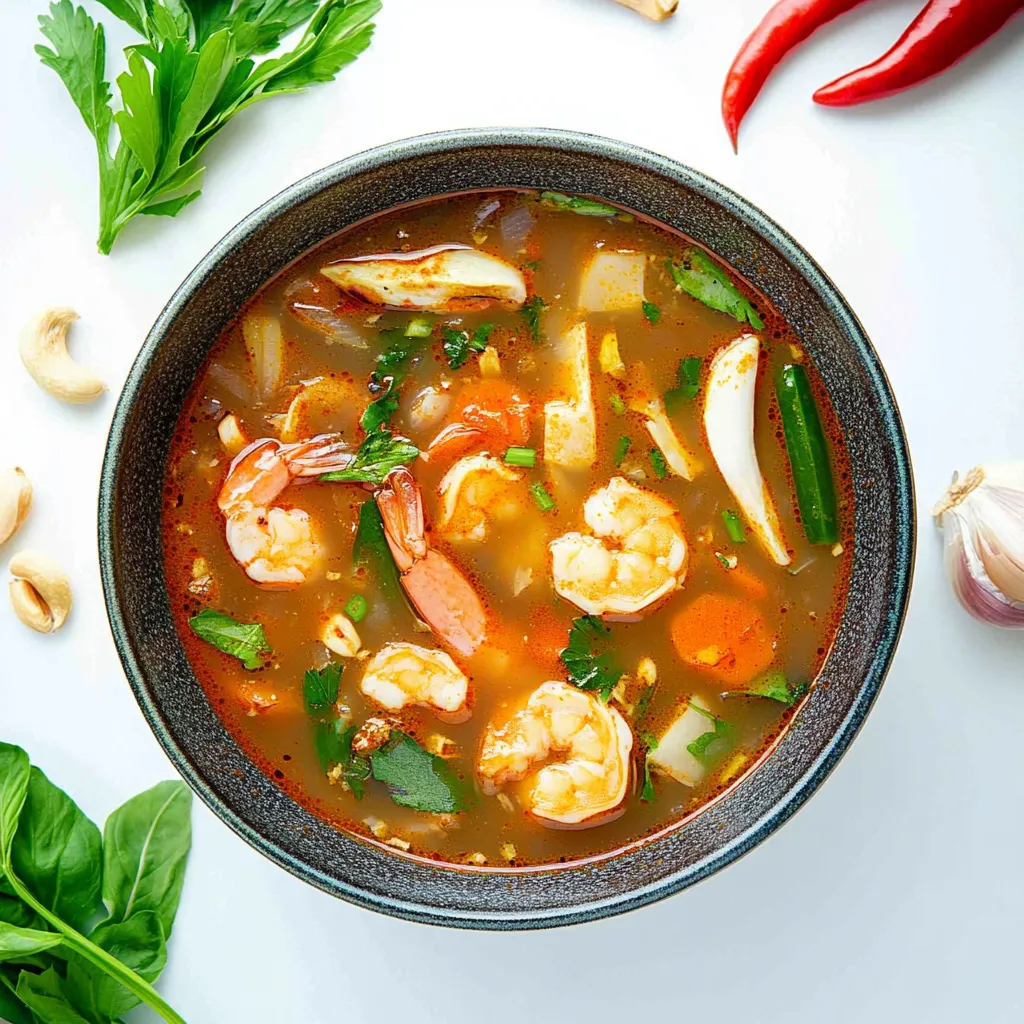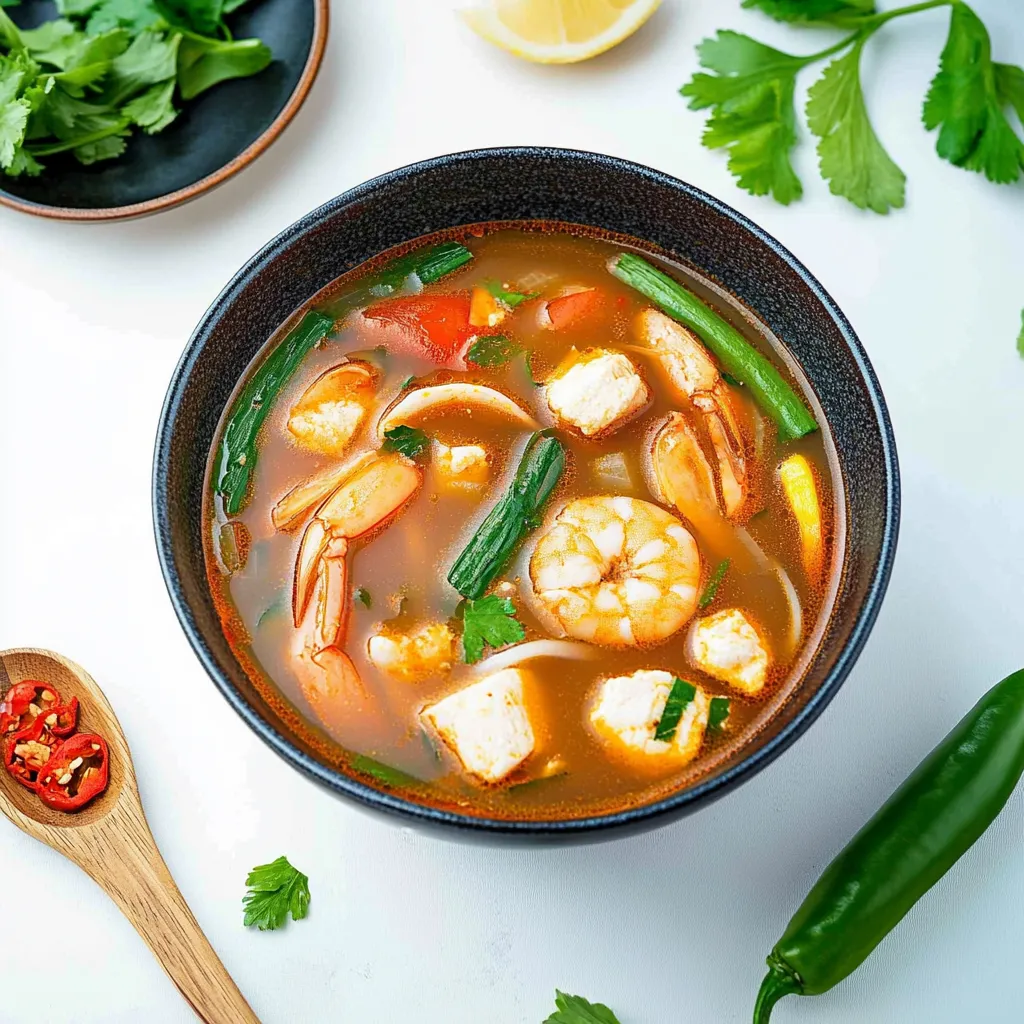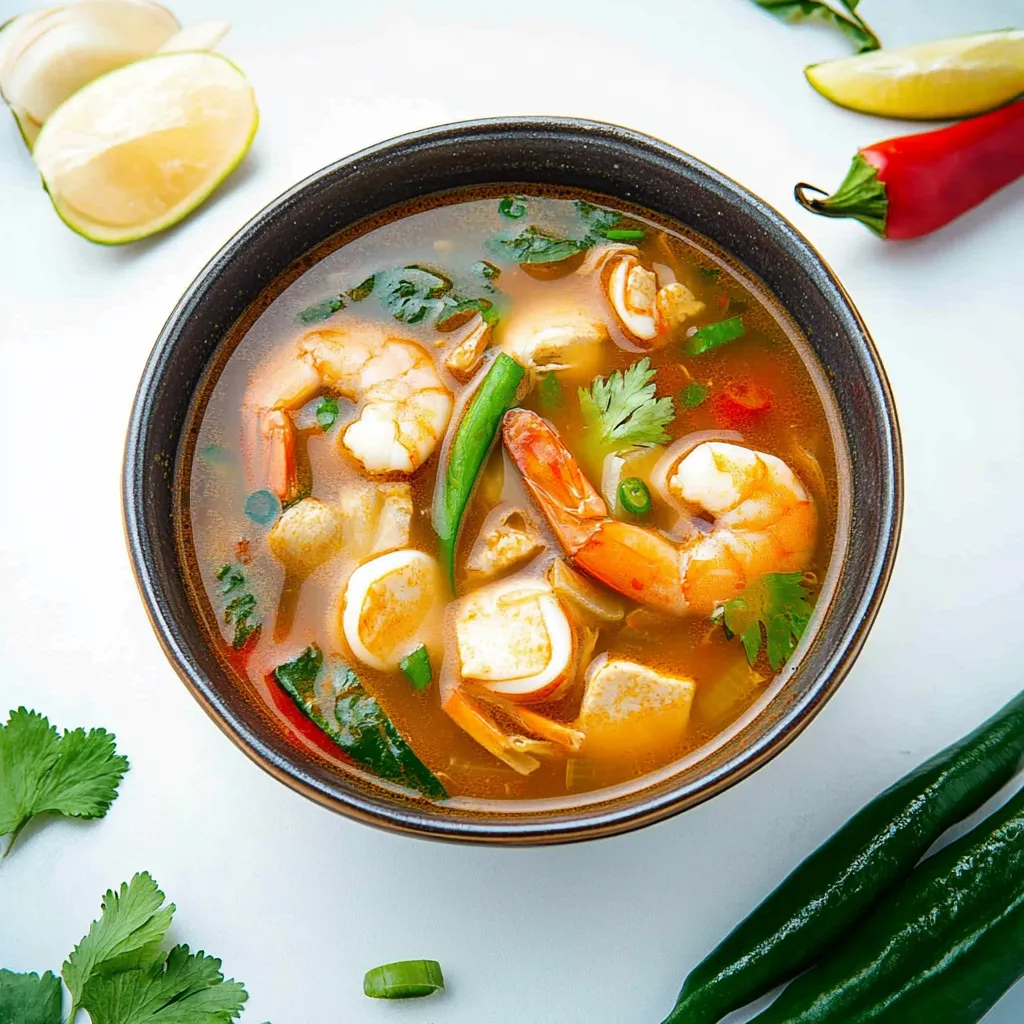 Pin it
Pin it
Imagine hovering above a bubbling pot of Tom Yum soup, with swirls of citrusy vapor floating up from a transparent liquid tinted with bright orange shellfish essence. This beloved Thai dish combines the tangy zest of lemongrass and kaffir lime with the subtle kick of bird's eye chilies, while juicy shrimp and soft mushrooms add substance. Every mouthful delivers a wonderful mix of spicy, tangy, and umami tastes that tickle your taste buds and heat you up from inside.
I first learned about Tom Yum in a tiny kitchen in Bangkok, where an older Thai cook showed me how the real secret is giving each ingredient proper attention. She taught me that cutting corners on the shrimp oil or not properly crushing the herbs would leave you with boring, plain soup. After trying many times to copy her methods, I've figured out that taking your time with each part makes a soup that captures Thailand's essence in every spoonful.
Key Ingredients
- Plump lemongrass stems: They should feel hard and smell nice - look for tight leaves and a citrusy scent when you scratch them
- Kaffir lime foliage: Need to be shiny and richly green, letting out their scents when lightly squeezed
- Complete uncooked shrimp with heads on: They're the basis for the orange-colored oil that makes real Tom Yum special
- Thai bird's eye peppers: Need to be vivid red and solid, they vary in spiciness, so use more or less as you like
- Galangal root: Its earthy, sharp taste can't be swapped for ginger, find pieces with smooth, firm skin
- Unwaxed limes: They bring the key sour kick - don't use bottled juice as it won't have the fresh zing you need
Crafting Shrimp Oil
Pull out all the flavor by slowly warming shrimp heads in plain oil on medium flame, giving them a stir now and then until they change from gray to bright red. Look for the moment when shells get crunchy and the oil turns deep orange, showing that the important oils and tastes have come out right. Filter with care, saving every bit of the valuable oil that will give your soup its special color and richness.
 Pin it
Pin it
Fragrant Foundation
Handle each aromatic carefully, cut lemongrass to get rid of hard outer bits, then slice and pound to free the essential oils. Split kaffir lime leaves down their center to release their smell. Cut galangal thin enough to share flavor but big enough to fish out later. Put these items in your pot in layers, letting their smells blend as they warm up.
Creating The Liquid
Start with cool water and heat it up slowly with your herbs, aiming for light bubbling instead of a hard boil. This gentle method stops bitterness while getting the most taste. Notice how the clear liquid slowly picks up a light golden shade from the soaking spices and herbs. This part usually needs 10-15 minutes, don't try to speed it up.
Timing Is Everything
Add each item in the right order. Begin with mushrooms, giving them 2-3 minutes to soak up the tasty liquid. Put shrimp in only when the soup has reached a soft simmer, since strong boiling will make them tough. Keep an eye on them - once they change from gray to pink, usually in about 45 seconds, they're ready.
Finding Balance
This last step needs your full attention. Put in fresh lime juice bit by bit, tasting after each splash. Pour in your saved shrimp oil, watching orange dots make pretty designs on top. Try it and tweak with fish sauce for salt, lime for tang, and peppers for heat until you hit that ideal Tom Yum harmony.
Living close to a Thai neighborhood showed me why we should respect old cooking ways. While helping at local food events, I saw that the most loved Tom Yum always came from kitchens that spent time on the shrimp oil and let the broth develop slowly. The extra depth and layers of flavor were really noticeable.
Great Companions
Make this soup part of a full Thai meal by putting it next to fluffy jasmine rice that can soak up the tasty broth. Add crunchy spring rolls for different textures, or serve it before some Pad Thai. For something lighter, match it with som tam (shredded green papaya salad) mixed with fish sauce and lime, so the clean flavors play nicely with the soup's punch.
Tasty Twists
Change up this traditional recipe while keeping its heart intact. For something richer, mix in coconut milk at the end, making Tom Yum Goong Nam Khon. Swap shrimp for other seafood - mussels, squid, and firm white fish all bring their own taste to the broth. For a veggie version, use mushroom stock and throw in extra mushroom types like skinny enoki and meaty king oyster for texture and flavor.
Keeping It Fresh
Keep parts separate to maintain quality - store the liquid in a sealed container, taking out any leftover herbs to avoid bitterness. Keep cooked shrimp apart to stop them from getting rubbery when reheated. The broth stays good in the fridge for up to three days; warm it gently and add new lime juice right before you eat it.
 Pin it
Pin it
This soup shows what Thai food is all about - layered yet balanced, strong yet sophisticated. The mix of fragrant herbs, hot chilies, and sweet shrimp makes a dish that's both soothing and thrilling. Whether you're fighting off a cold or just want genuine Thai flavors, this method gives you the true spirit of Tom Yum Goong.
Frequently Asked Questions
- → Where can I buy kaffir lime leaves?
- Try Asian grocery stores or look for dried/frozen options. In a pinch, regular lime zest works too.
- → Is the shrimp oil really necessary?
- You can skip it, but it adds amazing richness and true Thai flavor to your soup.
- → How hot will this soup be?
- You control the heat by adding more or fewer Thai chilies or chili paste.
- → Can I use shrimp without shells?
- Sure, but shells and heads really boost the flavor of your broth.
- → Should I add coconut milk?
- The creamy version (Tom Yum Nam Khon) has coconut milk, but the clear one is more traditional.
